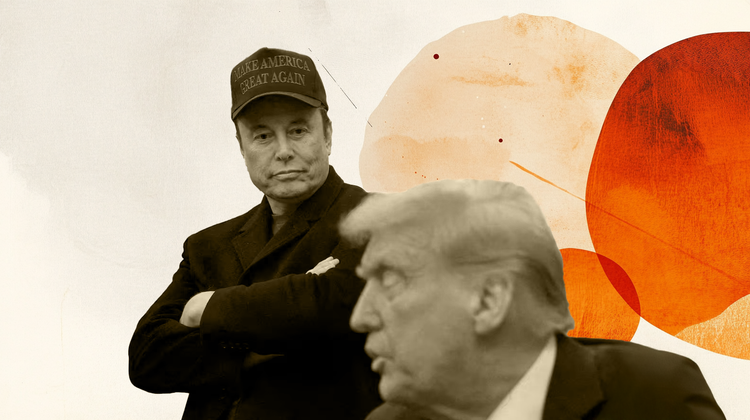The divorce
Markets opened Wednesday with cautious optimism after Trump’s 90-minute call with Xi Jinping appeared to break the rare earths deadlock and restart trade diplomacy. Treasury Secretary Scott Bessent, USTR Jamieson Greer, and Commerce Secretary Howard Lutnick were promptly named to lead follow-up talks, and for a brief moment, traders bit. Risk assets caught a tailwind. The dollar softened, gold dipped, and futures pushed higher on whispers of a thaw.
But the calm didn’t last long. By the afternoon, the narrative took a sharp turn—and Elon Musk was caught in the crosshairs.
In a public ambush, Trump unloaded on his former ally, blasting Musk for criticizing the GOP budget bill and mocking him with a now-viral “Trump Derangement Syndrome” jab. Within hours, the president escalated—threatening to cut all federal subsidies and contracts tied to Musk’s empire. “The easiest way to save money in our Budget, Billions and Billions of Dollars, is to terminate Elon’s Governmental Subsidies and Contracts,” Trump posted on Truth Social.
Markets didn’t take it well. Tesla shares collapsed as much as 17%, their worst day in five years, wiping out $267 billion in market cap since Musk left his advisory role. The broader tape rolled over in sympathy, with the S&P shedding more than 0.5% and tech-heavyweights losing altitude. What began as a trade-ceasefire bounce turned into a risk-off unravelling, and fast.
Musk didn’t back down—firing back on social media, accusing Trump of betrayal, and floating the idea of a third party. But for markets, this was no longer just a political spat. It was a reminder that in Trump’s second term, no one is untouchable—not even the guy who bankrolled the US new age rocket boom and helped finance his campaign.
Elsewhere, macro data added more noise to an already frayed narrative. The April trade deficit narrowed, largely a reversal of March’s tariff-driven hoarding. But initial jobless claims rose to their highest level since October, casting yet another long shadow over Friday’s NFP and raising questions about labour market momentum.
Over in Frankfurt, the ECB delivered its eighth rate cut in a year—no surprise there. However, what caught the market off guard wasn’t the move itself; it was the tone. Lagarde didn’t exactly slam the door on more easing, but she sure didn’t hold it open either. Instead of doubling down on dovish, the ECB leaned patient, suggesting July’s meeting is more placeholder than pivot—unless, of course, trade tensions rear their ugly head again. Indeed, not the “cut and crumble” script that some had expected for the Euro. With no urgency to race toward deeper accommodation, traders reassessed the euro’s downside, and what was supposed to be a dovish day turned into a mild euro flex.
Markets initially tried to climb the ladder on U.S.-China trade optimism. But Trump yanked that ladder out from under them by nuking Musk in broad daylight as the risk rally fizzles in a blaze of egos.
The view: Two egos too big for the same screen
What started as cautious optimism following the Trump-Xi call ended in a full-blown trading dumpster fire after the Musk-Trump cage match escalated.
Tesla didn’t just get clipped—it got obliterated. A 14% nosedive by the close, wiping out over $150 billion in market cap, after Trump unleashed a volley on Truth Social, threatening to axe every last federal dime flowing into Elon’s empire. This wasn’t a spat—it was a public breakup with budgetary consequences.
Retail got smoked. Tesla, still the crown jewel of every mom-and-pop dip buyer’s portfolio, imploded under the weight of political fury. And when the most loved stock in retail land breaks, the pain isn’t isolated—it’s contagious. MAG7 names followed suit as traders sold winners to compensate for the losses from Tesla, dragging the Nasdaq into the mud and turning early optimism from the Trump-Xi hotline into a footnote that would soon be forgotten.
The day turned into a cross-asset liquidation. Bonds? Dumped. Bitcoin? Slapped. Gold? Pumped and then rug-pulled. Even the dollar did its best impression of a stunned boxer—staggers, pukes, then somehow finishes flat. The 5Y note took the biggest hit, curve flattened hard (2s30s back to 3-week lows), and rate cut odds actually fell—because apparently, chaos isn’t dovish anymore.
Jobless claims jumped. Trade deficit cratered. ECB cut rates, but EURUSD rose. And while all that noise mattered on paper, the real market driver was the soap opera unravelling between Trump and Musk—two egos too big for the same screen.
And in the process, Trump may have handed the Democrats the biggest electoral gift of the decade. The Elon Army—one of the most mobilized, meme-fueled, MAGA-adjacent voting blocs out there—is now looking for a new home. For all the talk of Trump’s base being locked in, this was a self-inflicted wound with real consequences.
From a market lens, this wasn’t just volatility—it was a paradigm wobble. Musk isn’t just a stock. He’s a narrative anchor for a whole generation of growth-chasers. And Trump just blew that narrative to pieces.
By the close, there wasn’t enough duct tape left to hold together the early “handshake vibes” from the Trump-Xi call. The Dow limped down 108 pts (-0.3%), the S&P 500 shed 0.5%, and the Nasdaq took the brunt of it, down 0.8%—with traders messaging each other the same verdict: “what a shitshow.” Markets don’t like chaos without compensation
Tonight’s/Tomorrow’s NFP might bring some much-needed macro clarity, but does it matter?

